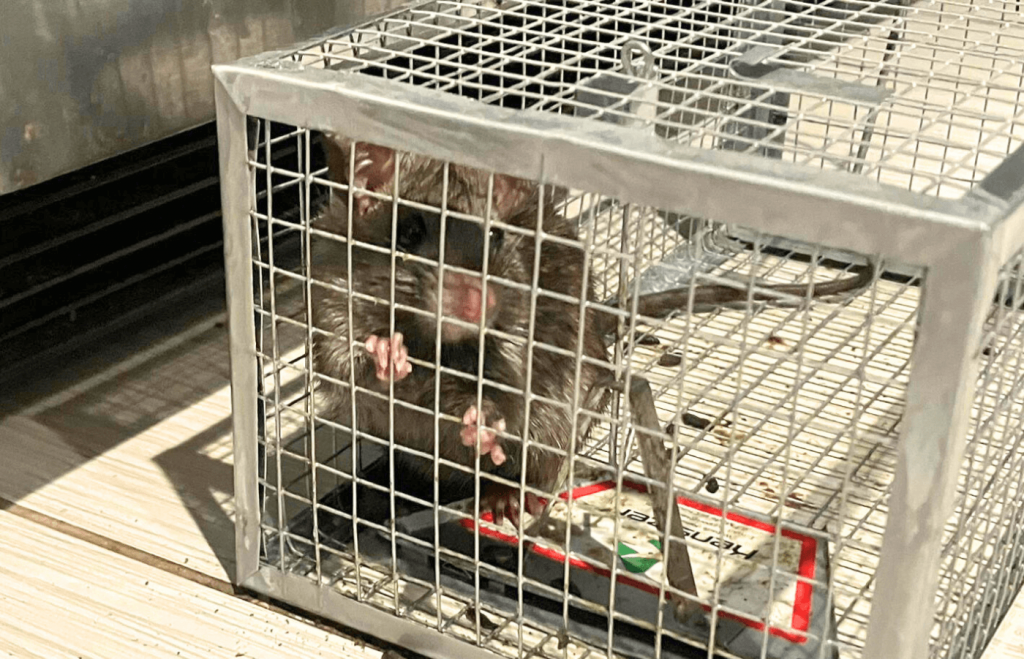Written by Dana Peer Levis.
Meet Ratty, the avocado-loving rodent who nibbled his way into my life and taught my family a valuable lesson about the importance of humane traps.
After finding his way into our home through holes in the wall behind our washing machine, Ratty quickly made a reputation for himself as an avocado thief. Curious and crafty, he managed to evade my makeshift humane traps, locating a new avocado every day and leaving behind the bread and peanut butter we had left out for him.
Not everyone was satisfied with my attempts to remove Ratty from my home humanely. Our landlord, who brought in a “pest” control team to seal off the walls, tried to give us cruel —but I knew better than to use those horrible, torturous devices.
Glue traps are among the cruelest methods of killing animals. Any small animal who walks across or lands on one becomes stuck in the sticky adhesive. They panic and struggle—often tearing off their fur, skin, or feathers—causing them to become more helplessly stuck. Some animals are so desperate to escape that they break their bones or even chew off their limbs. The terrified, injured animals die, sometimes days later, of blood loss, shock, suffocation, or thirst. Or they’re later crushed to death under piles of trash in the garbage, where the instructions on the traps advise consumers to dispose of them.
Seeing distressed, ensnared animals can also be extremely upsetting to children. With a young son, I wanted to set a good example by showing him that we must treat all animals with respect and compassion.
After we spoke to our landlord about humane methods, he gave us a deadline to remove Ratty. I had my work cut out for me, and the clock was ticking.
With mounting pressure from my landlord and the “pest” control team, I decided to ditch my homemade traps and buy a humane catch-and-release trap at the suggestion of a helpful coworker. And it worked!
With Ratty safely captured, we took him to our local botanical gardens down the road from our home to release him. Now, he has ample room to explore, forage, and make a proper nest.
Meanwhile, my son—who thoroughly enjoyed the situation—is playing with his new rat plushy, inspired by our weeklong houseguest. As it turns out, our experience with Ratty was a welcome opportunity to teach our son how to live in harmony with other animals.
Our catch-and-release success story serves as a reminder that traps designed to injure or kill animals are cruel and unnecessary. They also desensitize impressionable children to the killing of sentient beings. If you want to remove unwanted houseguests, follow these humane rodent control tips:
Contain food in chew-proof metal or glass containers, and keep garbage tightly sealed, even indoors. Keep surfaces, floors, and cabinets free of crumbs and spills. Consider moving some foods from the cupboard to the refrigerator.
Feed animal companions indoors, and then pick up their dishes.
Trim vegetation around buildings, and seal holes larger than a quarter inch in diameter, cracks in the walls and floors, and spaces around doors, windows, and plumbing. Never feed wildlife, including birds, as rodents are drawn to bird feeders.
Monitor rodent activity using a flashlight to identify entry points and frequented areas. Look for droppings, chewed areas, nests, and stored/cached food. Placing ammonia-soaked rags in areas where indications of animals or droppings are present will drive them out.
Rats and other small animals cannot tolerate the scent or taste of pepper. Make a mixture of edible oil, horseradish, garlic, and plenty of cayenne pepper. Let it sit for strain it into a spray bottle, and spray it in frequented areas. It won’t harm curious animals, but it will drive them away. Mothballs and peppermint oil–soaked cotton balls also make excellent rodent repellents.
Once animals are gone, use foam sealant, steel wool, hardware cloth, or metal flashing to seal entry points.
After rodent-proofing a building, live-trap and remove any rats or mice still inside. Use a commercially available, cruelty-free Havahart trap, or make your own. You can find reusable Humane Smart Mousetraps at the PETA Shop.
Check the trap hourly and release any captured rodents within 100 yards of where you caught them so as not to disorient them.
Be sure to clean your humane traps thoroughly and disable them when they’re not in use.
Show Compassion to Animals Like Ratty
Rats and mice are smart, family-oriented animals and can recognize their names. Show empathy to them by never using glue traps, snap traps, or poisons and by always choosing humane methods of rodent control.
You can also help by urging companies like Lowe’s and The Home Depot to stop selling cruel glue traps:
The post What an Avocado-Loving Rat Taught Me About Humane Rodent Control appeared first on PETA.

